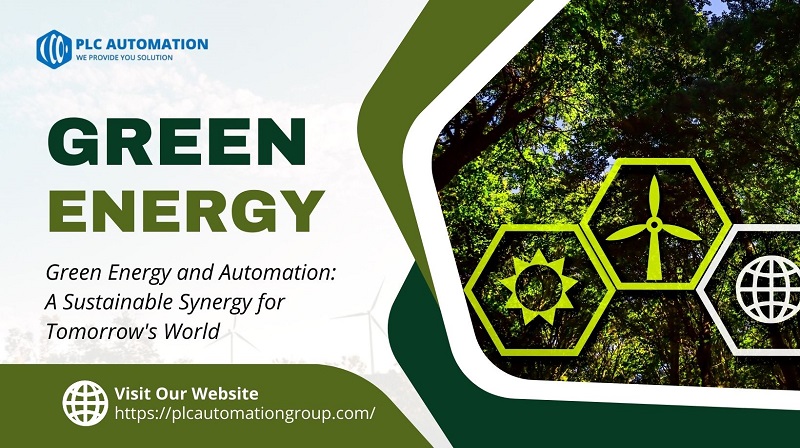
A Sustainable Synergy for Tomorrow's World with Green Energy and Automation
- by PLC
- Oct 17, 2023
As our planet grapples with the consequences of climate change, the urgent need for sustainable and environmentally friendly energy sources has become undeniable. Green energy, often referred to as renewable energy, is a beacon of hope in the face of environmental challenges. This blog explores the concept of green energy, its types, advantages, and its critical role in shaping a more sustainable and resilient future.
What is Green Energy?
Green energy, also known as renewable energy, is derived from sources that are naturally replenished and have a minimal environmental impact. Unlike fossil fuels, which are finite and release harmful emissions when burned, green energy sources are sustainable and clean. These sources include:
- Solar Power: Solar panels capture energy from the sun and convert it into electricity.
- Wind Power: Wind turbines harness the kinetic energy of the wind to generate electricity.
- Hydropower: This uses the energy of flowing water, such as rivers and dams, to produce electricity.
- Biomass: Biomass energy is generated from organic materials like wood, agricultural residues, and waste.
- Geothermal Energy: Geothermal power taps into the Earth's internal heat to produce electricity and heat homes.
Advantages of Green Energy
- Environmental Benefits:
- Reduced Carbon Emissions: Green energy sources produce little to no greenhouse gases, making them instrumental in combatting climate change.
- Improved Air Quality: Decreasing the use of fossil fuels for energy production leads to cleaner air and reduced pollution levels.
- Energy Security:
- Reduced Dependency on Fossil Fuels: Green energy diversifies the energy mix, reducing reliance on unstable or depleting fossil fuel sources.
- Energy Independence: Localized renewable energy systems provide greater energy security by reducing vulnerability to supply disruptions.
- Economic Opportunities:
- Job Creation: The green energy sector generates employment opportunities in manufacturing, installation, maintenance, and research and development.
- Technological Innovation: Green energy drives innovation in energy technologies, which can lead to economic growth and exports.
- Cost Efficiency:
- Long-term Savings: While the initial setup costs may be high, green energy systems typically have lower operating and maintenance costs, resulting in savings over time.
- Stable Energy Prices: Green energy is less susceptible to price fluctuations in fossil fuel markets, providing price stability for consumers.
- Climate Resilience:
- Adaptation to Climate Change: Green energy infrastructure can withstand extreme weather events better than conventional energy systems, enhancing resilience in the face of a changing climate.
The Path to a Greener Future
- Government Support: Policymakers play a crucial role in promoting green energy through incentives, tax breaks, and regulations that favor renewable energy adoption.
- Technological Advances: Continued research and development in green energy technologies are essential to improving efficiency and reducing costs.
- Community Involvement: Encouraging local communities to invest in and adopt green energy solutions can foster sustainability at the grassroots level.
- Consumer Awareness: Education and outreach are key to increasing public support and adoption of green energy practices.
- International Cooperation: Collaborative efforts between nations are essential to address global climate challenges and facilitate the transition to green energy on a large scale.
Green energy is more than just a buzzword; it's a solution to some of our planet's most pressing challenges. By harnessing the power of the sun, wind, water, and Earth, we can reduce our carbon footprint, create jobs, and ensure a cleaner, more sustainable future. Embracing green energy is not just an option but a necessity, and it's a path that leads to a brighter and more resilient world for generations to come.
The intersection of green energy and automation holds tremendous promise for revolutionizing the way we produce, distribute, and consume energy. In an era defined by the urgent need for sustainability, these two fields are converging to address environmental challenges, improve efficiency, and create a more resilient energy ecosystem. This blog explores the profound impact of automation on green energy, highlighting its role in advancing sustainable solutions.
Automating Green Energy Generation
- Solar Farms: Automation technology optimizes solar energy systems by tracking the sun's movement, adjusting panel angles, and cleaning panels to maximize energy output.
- Wind Turbines: Sensors and automation systems monitor wind conditions and adjust the orientation and speed of turbine blades for improved efficiency and energy capture.
- Hydropower Plants: Automation controls water flow and turbine operations, enhancing both energy production and environmental impact management.
- Geothermal Energy: Automation ensures efficient heat transfer and energy extraction from geothermal reservoirs, minimizing resource depletion.
- Biomass Facilities: Automated feedstock handling, combustion control, and emissions monitoring make biomass energy production more efficient and environmentally friendly.
Benefits of Automating Green Energy Generation
- Increased Energy Efficiency: Automation optimizes energy production processes, resulting in higher efficiency and reduced waste.
- Predictive Maintenance: Automated systems can predict equipment failures and schedule maintenance, minimizing downtime and costly repairs.
- Lower Costs: Automation reduces labor costs and improves the overall economics of green energy production.
- Real-time Monitoring: Automation allows for continuous monitoring of energy systems, enabling quick responses to anomalies or environmental changes
Automating Green Energy Distribution
- Smart Grids: Automation and sensors in the energy grid enable real-time monitoring and adaptive energy distribution, improving reliability and reducing energy wastage.
- Energy Storage: Automation manages energy storage systems, charging and discharging batteries at the most opportune times, reducing strain on the grid.
- Electric Vehicle Charging: Automated charging stations and payment systems support the growth of electric vehicles, reducing fossil fuel use and emissions.
Benefits of Automating Green Energy Distribution
- Grid Resilience: Automation enhances grid stability, making it more resilient to outages and extreme weather events.
- Load Balancing: Smart grid automation can balance energy demand and supply, reducing the need for backup power plants.
- Integration of Renewables: Automation helps integrate intermittent renewables like wind and solar seamlessly into the grid.
- Cost Reduction: Automation optimizes energy distribution, leading to reduced transmission losses and lower operating costs.
Automating Green Energy Consumption
- Home Energy Management Systems: Smart thermostats, lighting controls, and appliances enable homeowners to optimize energy use, reducing waste.
- Industrial Automation: Manufacturers use automated processes to optimize energy consumption and reduce carbon emissions.
- Building Management: Automated building systems can reduce energy consumption by controlling heating, cooling, and lighting based on occupancy and weather conditions.
Benefits of Automating Green Energy Consumption
- Energy Savings: Automation allows users to reduce energy consumption without compromising comfort or productivity.
- Emissions Reduction: Automated systems help reduce greenhouse gas emissions by optimizing energy use.
- Cost Reduction: Lower energy bills result from efficient consumption, providing financial incentives for automation adoption.
The marriage of green energy and automation is ushering in a new era of sustainability and efficiency. Through automation, we can maximize the potential of renewable energy sources, transform energy distribution, and enhance energy consumption practices. As we address the pressing challenges of climate change, the synergy between green energy and automation offers a path to a more sustainable and environmentally responsible future. It's clear that these two fields are not just shaping tomorrow's world; they are defining it.
 Author name: Mr. Benjamin Lin (Sales Executive)
Author name: Mr. Benjamin Lin (Sales Executive)
Contact No. : +65 6980-8259
Linkedin: https://www.linkedin.com/company/78855232/
Address: Singapore













